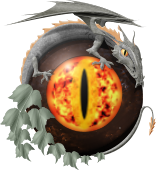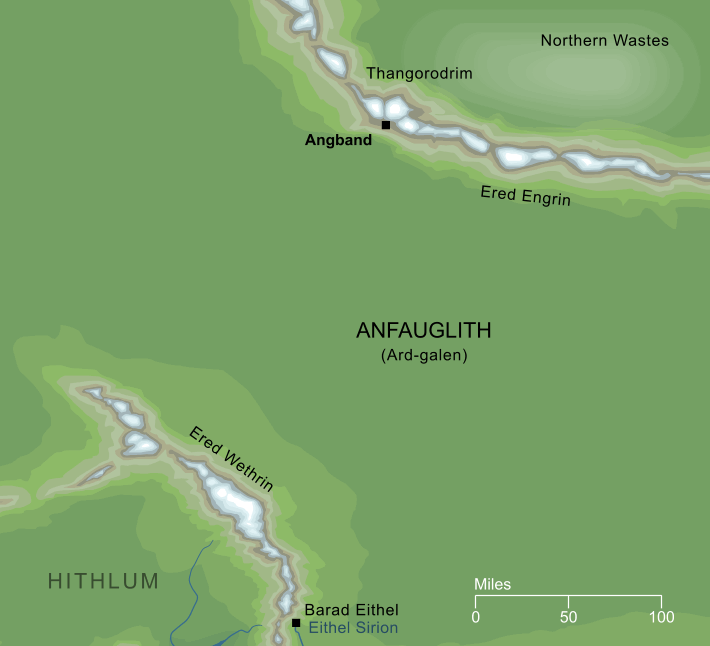- Cities and buildings
- Fields, plains and deserts
- Forests
- Hills and mountains
- Islands and promontories
- Lands, realms and regions
- Rivers and lakes
- Seas and oceans


 |
||||||
|


Which personality type are you?
Take the Free mydiscprofile Personality Test to discover your core personality and your ideal job.   Which personality type are you? |
|
Dates
Constructed in very ancient times, destroyed in the War of Wrath at the end of the First Age, c. I 587
Location
Far to the north of Beleriand
Origins
Race
Important peaks
The three peaks of Thangorodrim rose over Angband
Pronunciation
a'ngband
Meaning
Usually given as 'Hells of Iron', but the literal meaning is 'iron prison'
Other names
Indexes: About this entry:
|
AngbandThe Hells of Iron
(somewhat conjectural)1
(somewhat conjectural)1
Angband was a mighty fortified citadel originally constructed by Melkor in the earliest days of the world as an outlying fortress to his northern stronghold of Utumno. Utumno was destroyed by the Valar, and Melkor imprisoned in Valinor for three ages, but on his return to Middle-earth, he took Angband as the seat of his power, and raised the towers of Thangorodrim above its gates. Angband was beseiged by the Noldor after their return to Middle-earth, but the Siege of Angband was broken at the Dagor Bragollach. It was finally destroyed by the forces of the Valar at the end of the First Age, in the War of Wrath. Origins and HistoryAngband was first constructed in the ancient past of Middle-earth,2 originally as an outlying fortress and armoury to the great northern citadel at Utumno. It was commanded from its first construction by Sauron, the chief of Melkor's servants. Angband was built near the northwestern shores of the Great Sea in the range of the Iron Mountains, as a first defence against any attack on Melkor's realm from the Valar in Aman. When the Valar captured Melkor and took him in chains back to Valinor, Angband was largely destroyed and lay in ruins for many thousands of years, although beneath the ruins lay many hidden chambers in which some of Melkor's servants escaped the Valar's assault. Sauron was one of these, and the Balrogs lay hid with him in Angband's deepest vaults. Angband re-entered history when Melkor escaped Valinor with the stolen Silmarils: he chose the ruined fortress as his new capital, and rebuilt the Hells of Iron as a base for the dark reign he intended for the lands of Middle-earth. Soon after the Return of the Noldor to Beleriand, Morgoth took Maedhros by deceit and trickery, and hung him by the wrist from the towers of Thangorodrim above Angband. He was rescued by Fingon and Thorondor, but lost his right hand. The third of the great battles in the Wars of Beleriand, the Dagor Aglareb, had profound consequences for Angband. Until that time (the year I 60) Morgoth had sent out hosts of Orcs in the hope of taking the Noldor by surprise. The Noldor, though, chased these Orcs back to the very gates of Angband, and slew them to the last creature. From then until the Dagor Bragollach in I 455, a period of almost 400 years, Angband was surrounded by the Noldor; this is the time known as the Siege of Angband. Appearance and ConstructionAngband was primarily an underground fortress, at least after its initial destruction by the Valar in the Years of the Trees. Like its prototype, Utumno, it had many hidden underground chambers and vaults far beneath the earth. Its main features above ground were the three peaks of Thangorodrim, mighty towers of ash and slag raised above Angband's gates after Morgoth's return to Middle-earth. The peaks of Thangorodrim were hollow, and from them channels and chimneys ran down to the deepest pits of Angband. So, Morgoth could produce poisonous clouds and vapours, as indeed he sent against the Noldor in Mithrim during the first days after their Return. Notes
See also...Aman, Ancalagon, Anfauglir, Angainor, Angrod, Ard-galen, Arroch, Asgon, Balrogs, Barad Eithel, Barahir, Bauglir, Black King, Borlad, Bregolas, [See the full list...] Indexes: About this entry:
For acknowledgements and references, see the Disclaimer & Bibliography page. Original content © copyright Mark Fisher 1997-2000, 2008. All rights reserved. For conditions of reuse, see the Site FAQ. Website services kindly sponsored by Axiom Discovery aptitude and skill testing.Axiom Discovery gives you comprehensive online aptitude testing covering core skills across a wide range of disciplines. |